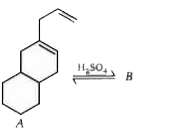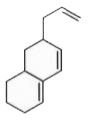Isomerisation.
n-Alkanes on heating in presence of anhydrous aluminium chloride and hydrogen chloride isomerise to branched chain alkanes. For example,
CH3CH2CH2CH3n-ButaneAlCl3/HCl−−−−−−−−−→575KCH3CHCH3∣CH32-Methylpropane
Topper's Solved these Questions
Similar Questions
D−Fructose with dil. NaOH undergoes a reversible isomerisation and is converted to a mixure of D−glucose, D−mannose and S−fructose.
Statement II: This reaction is known as Lobryde Bruyn-van Ekenstein rearrangement.
View SolutionFrom the following data, calculate the enthalpy change for the combustion of cyclopropane at 298K. The enthalpy of formation of CO2(g),H2O(l) and Propene(g) are −393,−285.8 and 20.42kJmol−1 respectively. The enthalpy of isomerisation of cyclopropane to propene is −33.0kJmol−1
View Solution
Knowledge Check

A isomerise to B on addition of traces of acid H2SO4. Compound (B) is :A B
B C
C D
D
Ph−CH=NO2Hisomerises−−−−−−−→3 days(x)(50−50%)Isomer (x) is :
APh−NO−CH2OHBPh−CH2−NO2CPh−NH−CO2HDNone
The heat of formation of C2H5OH(l) is −66kcal/mole. The heat of combustion of CH3OCH3(g) is -348 kcal/mole. ΔHf for H2O and CO2 are -68 kcal/mole respectively. Then, the ΔH for the isomerisation reaction C2H5OH(l)→CH3OCH3(g),and ΔE for the same are at T=25∘C
View SolutionThe equilibrium constant of the following isomerisation reaction at 400 K and 298 K are 2.07 and 3.42 respectively. cis− butenek1⇐⇒k−1trans - butene
Which of the following is/are correct?
I. The reaction is exothermic
II. The reaction is endothermic
III. At 400 K 50% of cis - butene and 50% of trans - butene are present of equilibrium
IV. Both at 298 K and 400 K, k1=k−1.
View SolutionThe system shown in the figure is in equilibrium, where A and B are isomeric liquids and form an ideal solution at TK. Standard vapour pressures of A and B are P0A and P0B, respectively, at TK. We collect the vapour of A and B in two containers of volume V, first container is maintained at 2TK and second container is maintained at 3T/2. At the temperature greater than TK, both A and B exist in only gaseous form.
We assume than collected gases behave ideally at 2TK and there may take place an isomerisation reaction in which A gets converted into B by first-order kinetics reaction given as:
Ak−−→B, where k is a rate constant.
In container (II) at the given temperature 3T/2, A and B are ideal in nature and non reacting in nature. A small pin hole is made into container. We can determine the initial rate of effusion of both gases in vacuum by the expression

r=K.P√M0
where P= pressure differences between system and surrounding
K= positive constant
M0= molecular weight of the gas
If vapours are collected in a container of volume 8.21L maintained at 3T/2K, where T=50K, then the ratio of initial rate of effusion of gases A and B is given as
View SolutionThe system shown in the figure is in equilibrium, where A and B are isomeric liquids and form an ideal solution at TK. Standard vapour pressures of A and B are P0A and P0B, respectively, at TK. We collect the vapour of A and B in two containers of volume V, first container is maintained at 2TK and second container is maintained at 3T/2. At the temperature greater than TK, both A and B exist in only gaseous form.
We assume than collected gases behave ideally at 2TK and there may take place an isomerisation reaction in which A gets converted into B by first-order kinetics reaction given as:
Ak−−→B, where k is a rate constant.
In container (II) at the given temperature 3T/2, A and B are ideal in nature and non reacting in nature. A small pin hole is made into container. We can determine the initial rate of effusion of both gases in vacuum by the expression

r=K.P√M0
where P= pressure differences between system and surrounding
K= positive constant
M0= molecular weight of the gas
Vapours of A and B are passed into a container of volume 8.21L, maintained at 2TK, where T=50K and after 5min, moles of B=8/3. The pressure developed into the cotainer after two half lives is
View Solution
